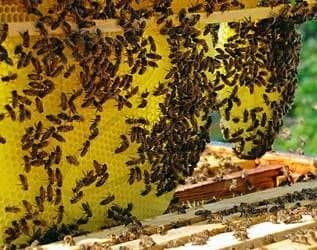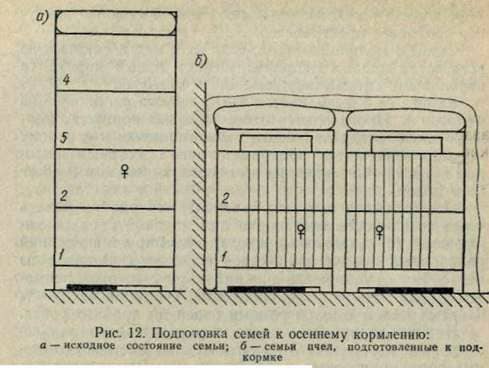
The work is performed on August 8-15, at the end of the honey collection. Selection of honey hulls, formation of a nest for preparation for wintering and autumn building of bees, feeding of bees with sugar syrup, 12-15 kg of sugar per basic family and 6-8 kg per batch are made.
After removal of the honey hulls, which is convenient to do a day after placing under the honeycomb body of the diaphragm (with bee removers), the upper brood body will be formed as a stern. Brood from it is usually removed to the lower body and, depending on the strength of the family, set 8-9 honeycombs per 1 / 2-3 / 4 occupied with honey with inclusions of perga on the outer cells.
The lower body is formed from the brood honeycombs with the setting in the middle of 3-4 small-copper light-brown honeycombs suitable for oviposition. The frames of the upper shell must be built up to the lower bar, and the streets between them 12 mm. The edge occupy the framework with the Perga, which are needed for the processing of sugar and brood rearing. Then they are cleaned.
The number of cells left in the winter in the upper and lower cases should be the same. The parts of the hulls (not occupied by cells) remain free.
After the formation of the nest on the ceiling, which has holes for the passage of bees, a feeding bowl with a capacity of at least 3-4 liters, a roof and a roof are put. The beehive is completely insulated from the outside, and the top-dressing of bees begins with sugar syrup. Sugar is given in such a way that in the winter bees spend it, and in the spring they eat honey. Feeding is given in the form of a syrup 1: 1 for 2 liters a day, so that the bees, processing large amounts of syrup, do not limit the oviposition of the queens.
Before filling the feeders through the funnel and the opening in the roof, it is necessary to check whether the syrup is selected from the previous distribution. In a syrup of 25 liters, a bottle of fumagillin is added to prevent nosematosis in the winter and spring periods. To suppress the development of the tick and stimulate the development of bees, preparations and infusions based on pine needles and wormwood are added to the syrup.

To feed the family 12-15 kg of sugar, you need to give her 19-24 liters of syrup 1: 1. At the indicated mode of autumn feeding up to 40% of sugar is consumed by bees for brood rearing and processing of syrup. In winter feed from the total amount falls 7-9 kg of sugar, which is equivalent to 9-11 kg of feed.
With the impossibility of regular feeding, you can give syrup and large portions, but you need to finish the top dressing in early September, heating the pavilion in cold weather.
After the end of feeding, it is recommended to check the filling of the forages of the upper body and, if incomplete frames are found, it is necessary to supplement the family until the honeycombs of the upper shell are filled.
In the layers going into the winter, there must be at least 6 small streets of bees. They put on 6-7 frames in the body.
At the end of the first decade of September (after 5-6 days after the end of feeding), it is necessary to remove the insulation from the hulls, to strengthen the ventilation in the hives. To stop the laying of eggs by the uterus and to exclude the withdrawal of the late brood, which can lead to a division of the club and the death of its lower part. Warming of the ceiling during this period and later feeding through the ceiling trough is capable of provoking the club pressing against the ceiling and the death of bees from lack of food, although it is much lower.
The leaves are reduced to 40-50 mm and keep open from the side where the frames are shifted in the cases.
As practice shows, it is better to form winter nests of bees in the hives of the pavilion in pairs, proceeding from the fact that in winter the hives, in addition to individual ceiling cushions, have general external warming and clubs of neighboring families can noticeably heat each other, because the gap between the hives is small and the walls of the hulls are thin.
When pairing in extreme families, the frames are shifted from outside, cold side walls to the neighboring hive, and in it a nest is formed on the side to which the extreme family is pressed. So do the other families of bees, forming nests in neighboring hives nearby.
Single pumping honey in mid-August provides a high-quality, fully ripe honey, which has the highest dietary and medicinal properties.
Multiple pumping of honey from partially sealed honeycombs significantly reduces its quality, since such honey does not have time to ripen because of incomplete processing by its bees.
Рамки для катка. Пленка вместо холстика.
Contents of bees in the pavilion